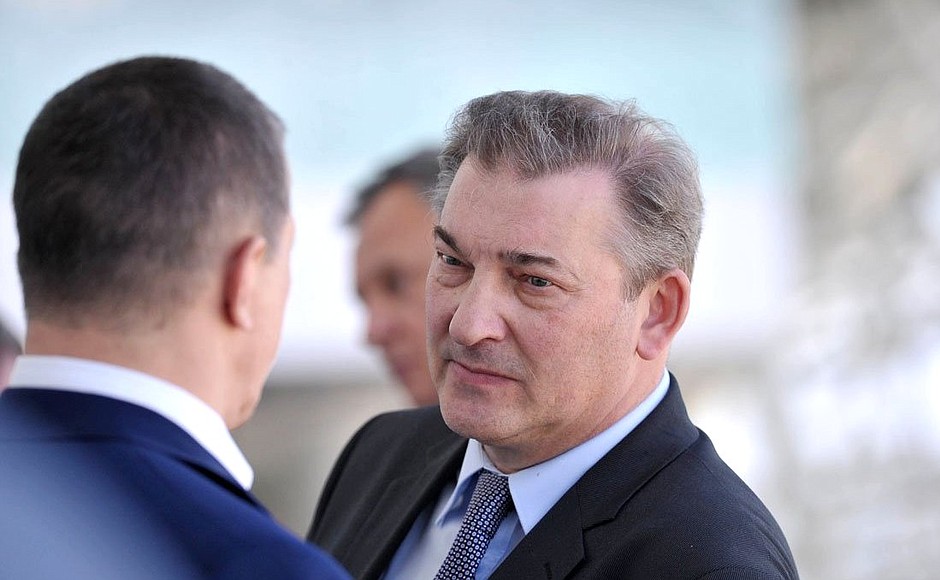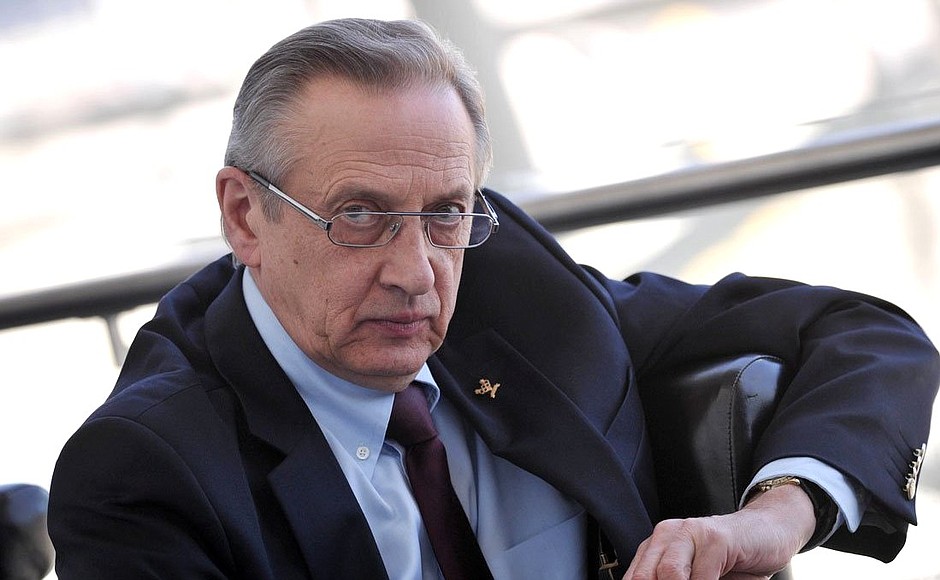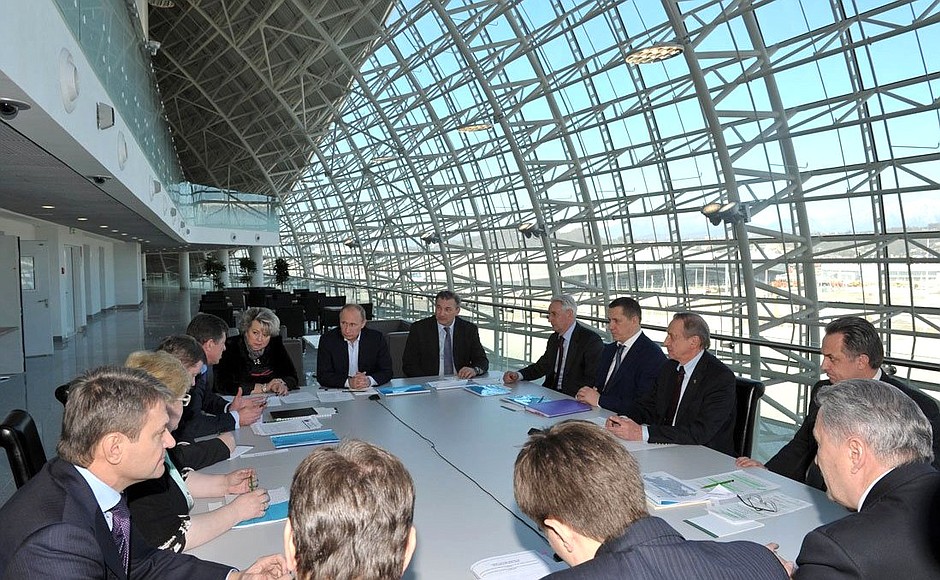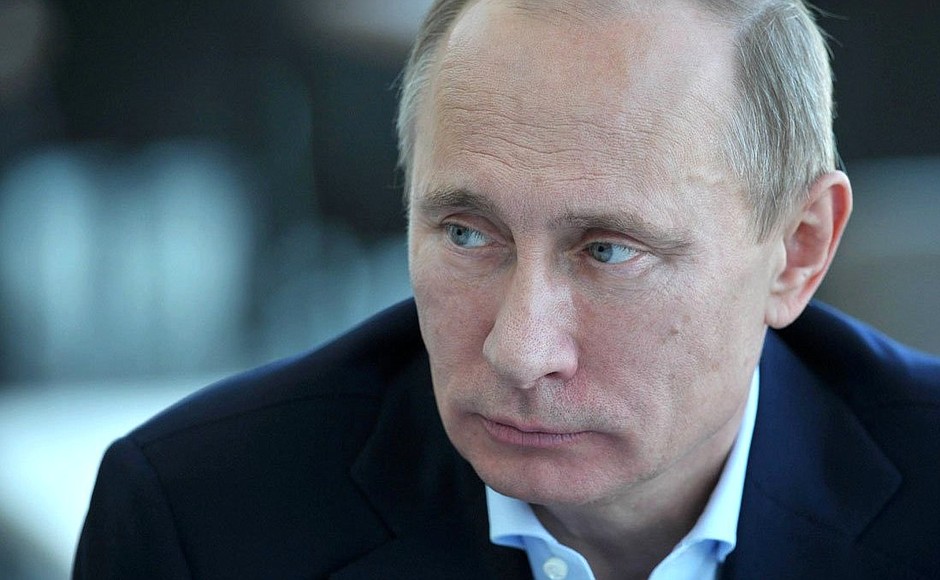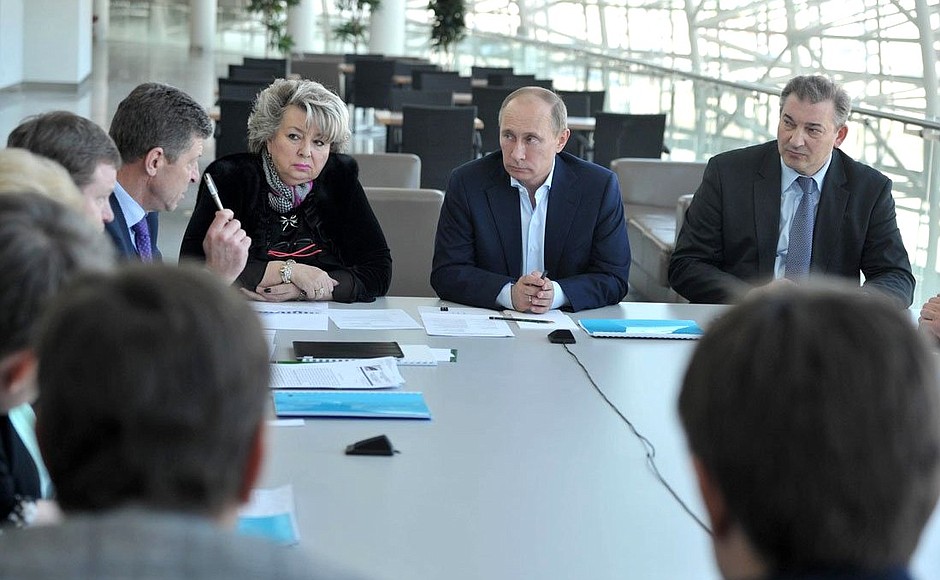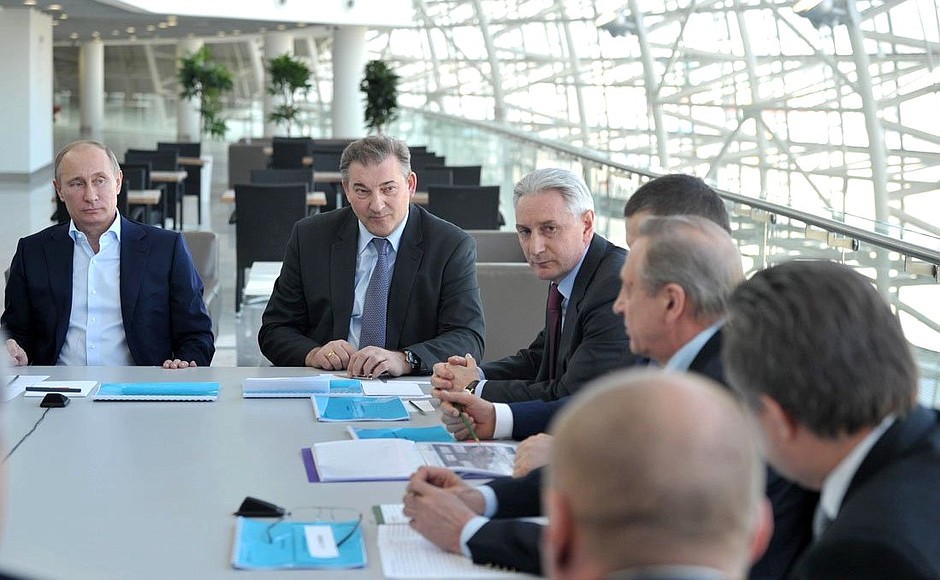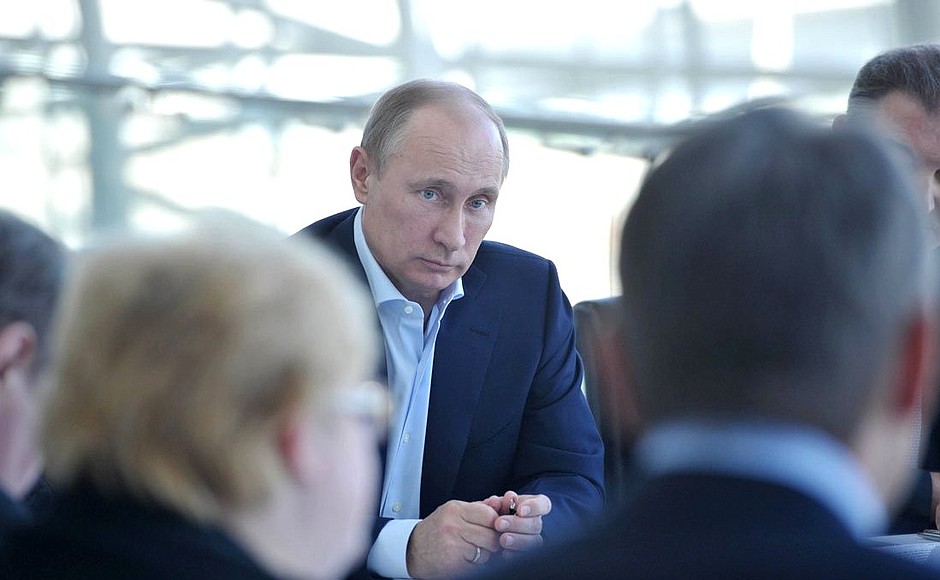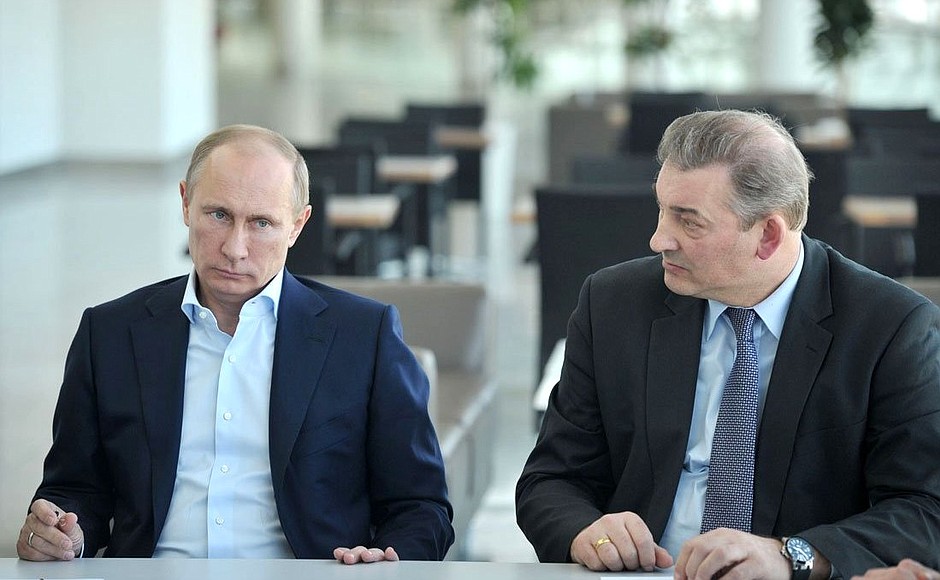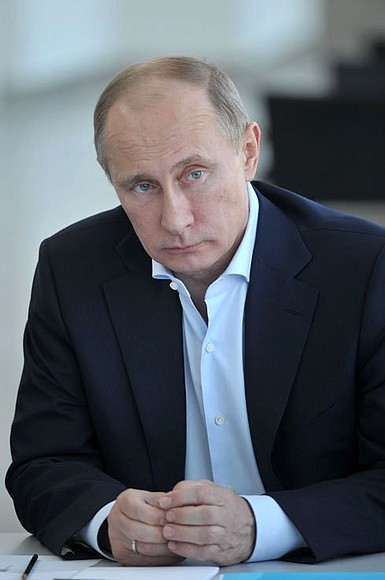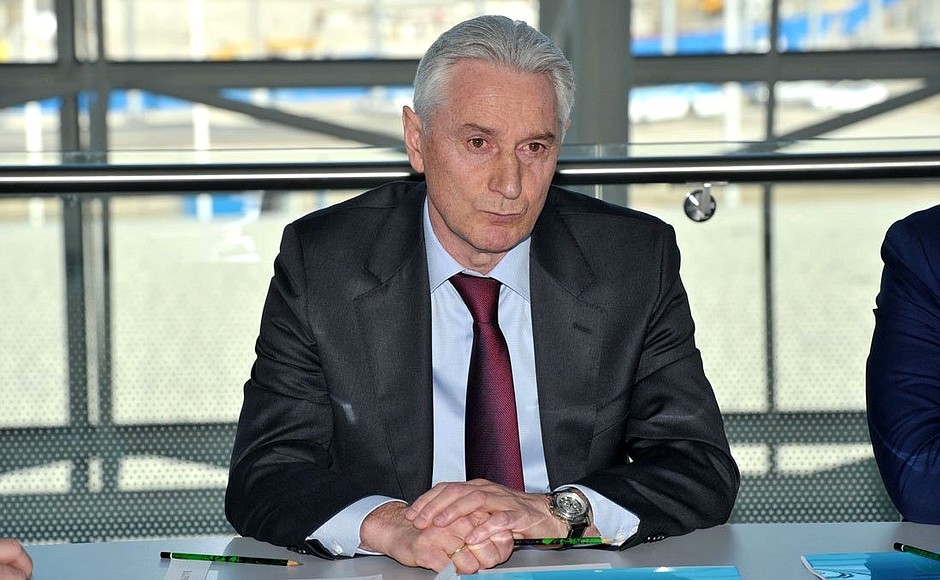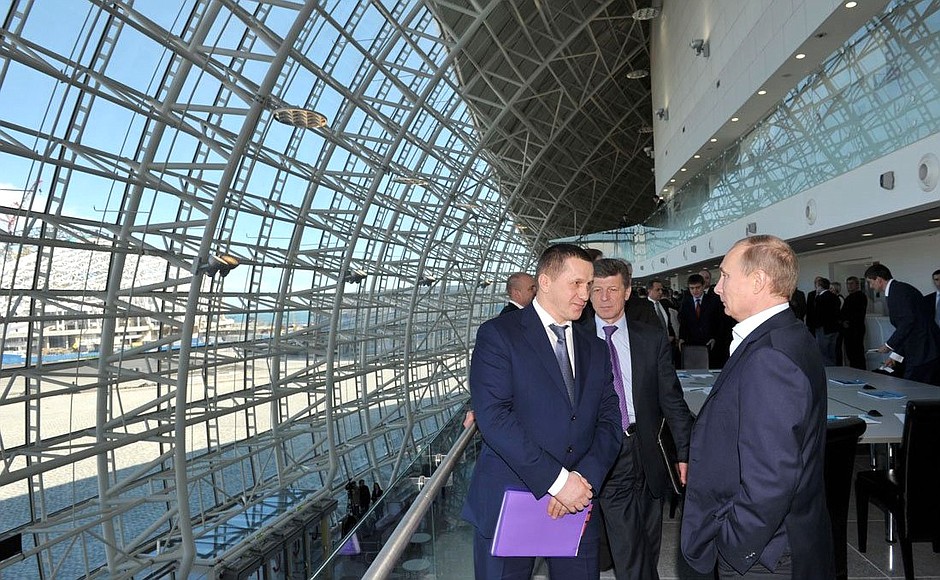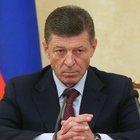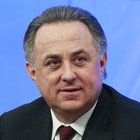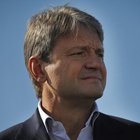The meeting participants discussed plans for the use of Olympic facilities after the 2014 Olympic Games. The President supported the idea of creating a national children's sports and education centre based on the Small Ice Rink [Malaya ledovaya arena] in Sochi.
* * *
President of Russia Vladimir Putin: Good afternoon colleagues.
We are meeting here in the Imereti Valley, on the Black Sea coast, right at the centre of the future Olympic events. We are here to discuss what will come after the Olympics, what will happen to the legacy inherited from the Games. To put it more specifically, we are here to discuss how we plan to use the facilities that have already been built or are being built for the 2014 Olympics.
I know there are various proposals. Let’s go over them again. I’d like to hear all the developments, how you plan to use the different facilities, and which particular facilities will be put to new uses.
[Addressing Deputy Prime Minister Dmitry Kozak] Maybe you will start? You approved the programme, as I far as I know, in any case, you have been working closely on it over this time and had drafted preliminary plans.
Let’s hear about these plans.
Deputy Prime Minister Dmitry Kozak: We have decided what will happen to all of the facilities that had not as yet been the subject of discussion. The future of practically of all the facilities being built for the Olympics is thus settled. On February 9, we approved the programme for post-Olympics use of the facilities and settled the timetable for handing over all of the sports facilities, the non-sports facilities, transport and infrastructure facilities, electricity network installations, and land that will be freed up after construction. These matters have all been settled now except for one facility that we are still discussing, namely, the ice figure skating centre.
There were no discussions on the centre’s post-Olympics use before competitions began there. Later, it was proposed to turn it into a cycling track. We do not currently have any state training centre for cycling, and the climate and geography here make this an ideal place to establish a training base for cyclists.
But then our hockey players held some competitions here and the request came to look at the centre’s future once again. That is why a decision has not yet been made regarding this particular facility. We have to decide what to do with it and weigh up all the pros and cons. The top priority is to set up a suitable training base for our sportspeople. Making sure the facility is used effectively in economic terms is important too, since a lot of money was invested in building it and we are to make sure that it works to full capacity for Sochi, the region, and Russian sport in general.
The other facility we still have to decide on is the small ice stadium. The programme for post-Olympic use of the facilities has not settled its future yet. We propose keeping it in the programme. Krasnodar Territory has made proposals, and the Culture Ministry proposed turning it into a venue for a circus. We are currently examining these proposals.
As for the other facilities, they will keep their original purpose. There are four training arenas – two for figure skating and short track, and they will stay here and will continue to be used for these purposes, one ice rink for the figure skaters, and one for short track.
There are another two on the coast, behind the stadium. There is the small ice arena and a training centre with two ice hockey rinks. The programme has already decided that this training centre will be moved to Stavropol. We have already settled this matter with the regional authorities and the Sports Ministry.
Sports Minister Vitaly Mutko: Mr President, we are looking at the post-Olympic inheritance in terms of putting it to use to develop figure skating and ice hockey around the country in general. We approved a sports development strategy in 2009, and over the last five years we have built 179 ice stadiums around the country. Today, 76 of the country’s regions have their own ice stadiums, and we will build a further 101 stadiums around the country by 2016.
Ice hockey and figure skating are becoming ever more popular now, and this has also given a boost to the system for training young people in these sports. Over recent years we have already got 83,000 children taking part in ice hockey training. This is an increase of around 15,000.
(The minister then gave information on the year-round training centres for ice hockey players in Russia and the possibilities for future use of the Olympic ice arenas).
* * *
Krasnodar Territory Governor Alexander Tkachev: The post-Olympic inheritance is hugely important for the region and its people of course. We’ve got the speed skating centre here before us, for example. Our speed skaters won a competition here recently.
This facility has an area of 20,000 square metres. In September 2014, we will hold the first Sochi Forum here. The facility will then work year-round as an exhibition centre along the lines of similar venues in Hannover and Nice.
We have a world-class media centre of 160,000 square metres in area. The media will use it during the Olympics, and afterwards, we plan to turn it into a big shopping mall, looking at the experience of places like Dubai and other resort centres.
Many retailers have already expressed interest. I think this is a promising project. The Olympic Park here in the Imereti Valley will become home to around 100,000 new residents who will buy apartments here or stay in the local hotels. We hope to have them come in both summer and winter, and they will visit the shopping mall of course, which will have cinemas and other entertainment facilities. I think this is a good idea. This is part of what we plan to do after the Olympics, and then there is also our ‘Disneyland’ – Sochi Park.
* * *
President of the Russian Ice Hockey Federation Vladislav Tretyak: It is true that ice hockey is becoming more and more popular in southern Russia. Look at Chechnya, Daghestan, and North Ossetia, where the federal targeted programme has got more boys playing ice hockey. This has a social dimension too. We have taken 500 children off the streets this way. I therefore think that we really should look at building a children’s sports school, all the more so as we have this hockey stadium already right here now.
First, we should put the organisational structure in place: a youth hockey league and a senior league. This would not require such a lot of money. We would have the hockey training centre, operating year-round, and would be able to keep it working, hold youth and junior championships here. Krasnodar Territory already has a team in the senior league now. More people are coming to watch hockey now and a 3,000-seat stadium is already not enough. We will eventually turn people into hockey fans like they have in the USA, in Anaheim and Los Angeles. Everyone used to laugh and say you’d never make hockey a big sport in places like that, but now it’s practically impossible to get hold of a ticket. In the future, this could someday become the home of a continental hockey league. I think it would be an excellent thing if we do create this whole infrastructure.
Regarding what Ms Tarasova [senior trainer of Russia’s national figure skating team] said about absolutely needing to have a place where our sportspeople will live and train, this is indeed the case. At the moment, our hockey teams go to Turkey or Finland because we do not have the conditions in place here for organising training sessions. We would be able to play hockey here, but if we have several teams here, especially during the winter training season, we would have to have accommodation for them. We visited the Olympic Village and looked around. It would be wonderful if it could be used later as accommodation for the hockey players and figure skaters.
The cost of plane tickets is also an important factor if we are to hold training sessions here. If some kind of preferential conditions could be put in place our hockey players and figure skaters would come here to train.
Senior Trainer of Russia’S National Figure Skating Team Tatyana Tarasova: We really ask for this; it’s very important for us.
Vladislav Tretyak: We will have a school here, and the ice hockey team will train here. Of course there is to be a big multipurpose centre here that could hold concerts in summer, say, when there are lots of holidaymakers. There is a second ice rink too, one that the general public could use, and people would be happy to come and make use of it.
Vladimir Putin: It’s all possible to do, and it will be like that here.
The ice could be covered if required in any case in order to hold different kinds of competitions.
Vladislav Tretyak: Basketball, volleyball, all kinds of sports. We are already holding one of the matches in the European Champions’ Cup here, holding the European tournament with Sweden, and we will be holding the world championship here, the junior world championship on April 18.
There was another thing I wanted to mention. Do you remember the Artek Young Pioneer Children’s Summer Camp? We used to have children from all around the country coming there and it was a real holiday for them because many of them had never seen the sea before. We could open a similar kind of year-round centre here and bring the best hockey players here. Our professional young hockey players could come here for 2–3-week sessions, and we would send people from the hockey federation to organise seminars and training sessions for them. This would be a good idea.
Tatyana Tarasova: We would do the same kind of thing.
Vladislav Tretyak: This would be a very important thing. We could bring the figure skaters and hockey players here. I think it is worth doing. I don’t know your view on the idea, but I think it would be good to bring children from Siberia, say. This is a historic place and these young hockey players and figure skaters could spend 2–3 weeks by the sea and build up their strength, train at the wonderful stadiums we have here.
* * *
Vladimir Putin: I propose that after the Olympics the small ice stadium be turned into a national children’s sports and education centre.
We discussed this idea yesterday with the Government officials. This is not the same thing as Orlyonok or Okean [national children’s centres on the Black Sea and the Far East], but would be a year-round sports and education centre where the children would live and study. We would have to decide where they would actually live and how many would come. They are not the national teams and do not have to live right here on site, but it could be possible to set aside part of the Olympic Village for them.
They would be training for sports such as ice hockey, figure skating, alpine sports too, such a cross-country and downhill skiing, biathlon, perhaps snowboarding. This would be for the Sports Ministry and the Olympic Committee to decide. This would be a federal centre financed by the federal budget. There is no other way to organise this work. But it would be focused on children’s and junior sport, not on top-level sport, but on mass children’s sport. National teams would certainly be able to train here too of course, and put on performances, because this would bring the children closer to top-level sport and encourage them to aim for higher results.
Most important of all is that children from all around the country would be able to spend a month, say, at the Black Sea and play sport instead of wasting time, study and train all at the same time.
I ask all of you, Mister Mutko, Governor Tkachev, and Deputy Prime Minister Kozak to think about where this centre could be set up. It could be possible to buy up an existing site, or build something new. I think it might be easier to do in the alpine facilities cluster. Here, it’s more complicated, but it is also possible.
We also should start looking right now, during the current budget process, at how much money will be required and how it should be invested in 2014 and the subsequent years.
I think this decision is fully in keeping with the Olympic movement’s spirit and purpose.
Aside from anything else, it could also make a real visible contribution to developing mass-scale children’s and youth sport.
I think we certainly should leave this training stadium for figure skating and leave the small ice stadium for hockey and use it as a training rink. If the figure skaters think they could get by without that ice stadium, it could of course be turned into a cycling track.
Dmitry Kozak: If it is turned into a cycling track this really would need to be settled before the start of the budget process. We would have to settle the cost estimates for the children’s centre and the school, work out the expenses we would be looking at, because the final decision would depend on the costs involved. Let’s work through all of these issues before May 15 with the Sports and Education Ministries and the regional authorities, work out all the costs, and then make our report.
